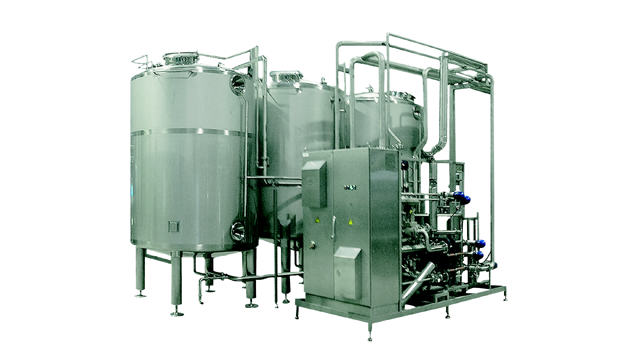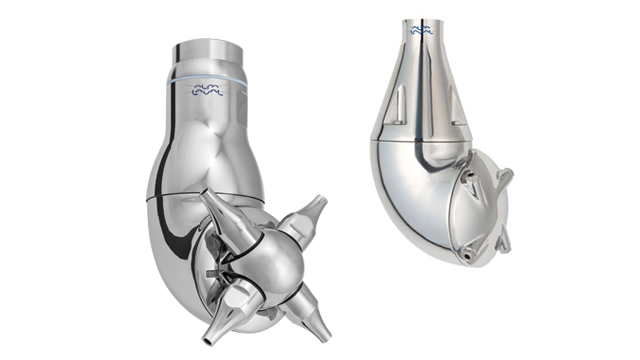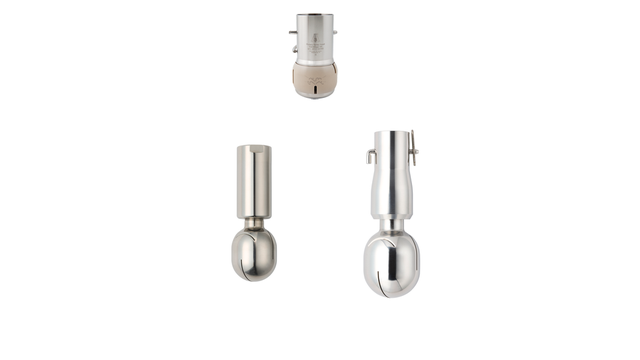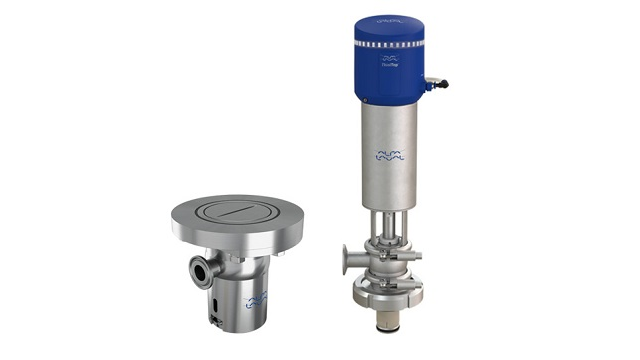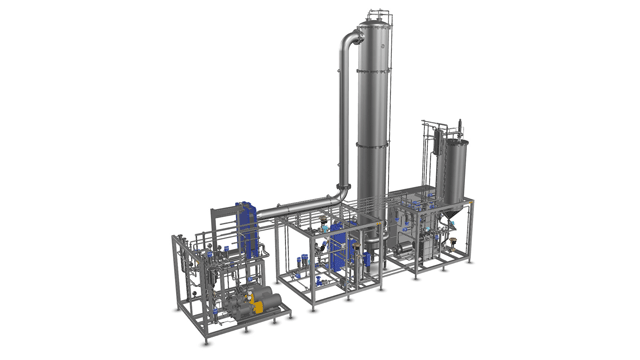Q&As about Cleaning-in-place
For water rinsing, is it okay to use clean incoming water with a chlorine content of less than 1 ppm?
That should be fine. 304 stainless steel is resistant to corrosion by chlorinated water with up to 2 ppm chlorine content, and 316 stainless steel can tolerate chlorine content of up to 5 ppm. All of our tank cleaning machines are manufactured using 316 stainless steel.
What are your recommendations for cleaning a DN 150 or DN 200 pipeline? We recommend cleaning these pipelines using a minimum velocity of 1.5 m/s. To reach the required minimum velocity, you need a flow rate of 1000 hl/h in DN 150 pipe or a flow rate of 1700 hl/h in DN 200 pipe.
Compared to using a normal spray ball, is it sufficient to conduct caustic bursts every two to three minutes using an Alfa Laval Rotary jet head? For burst cleaning with a TJ40G Rotary jet head, it is best to use TJ40G with the special burst nozzles, which have a special cut in the sides of the nozzles. These special cuts provide a diffuse fan flow for fast wetting during burst cleaning. With this machine, bursts of about one minute are usually sufficient.
Is there any maintenance required for Rotary spray head? TJ40G Rotary jet heads have a service interval every 500 operating hours, alternating between minor service at 500 hours and 1500 hours, and major service at 1000 hours and 2000 hours. These service kits contain all required parts, and the kits and service videos demonstrating service procedures are available from Alfa Laval. Rotary spray heads do not have recommended service intervals; however, spare parts are available from Alfa Laval.
Will you be talking about Rotacheck? I would like to know how it works. Rotacheck is an instrument used to validate the rotation and proper function of an Alfa Laval Rotary jet head tank cleaning machine. It is a pressure sensor that registers the impact of the jet flow on the sensor. A properly functioning Rotary jet head will provide periodic hits on the Rotacheck, while a machine that stops rotating will not.
Can you switch between the burst function and no-burst function? The TJ40G burst machine provides both diffuse fan flows from the sides of the nozzles for burst cleaning and standard jet flows from the ends of the nozzles for impact cleaning. So the machine can be used both for burst cleaning and standard cleaning.
What about the sealing material – gaskets and o-rings – used in the CIP systems? What are the MOCs (or materials of construction) and how often is replacement required? Typically, we recommend replacement of gaskets and o-rings at the same time as the machines themselves are being serviced, or about every two years. Typically we see EPDM or FKM used in gaskets or o-rings, though occasionally also PTFE gaskets.
If I have to design a TJ40G, do I need a pressure of 7.5 bar at the outlet of the pump? It seems very high.
To reach 5 bar at the TJ40G inlet at the top of the tank, you will need a pressure of approximately 7.5 bar at the outlet of the CIP-F pump. Remember that there is at least 1-2 bar of hydrostatic pressure drop due from the height difference to the top of the tank as well as friction losses through the pipe.
Is it possible to conduct cleaning of pipe with a larger diameter at 1 m/sec? For CIP in pipes, a minimum velocity of 1.5 m/sec is recommended in order to reach the required turbulent flow and sufficient wall shear stress necessary to clean the pipe.
What is the maximum diameter of vessels that can be cleaned with Alfa Laval Rotary spray heads? Alfa Laval Rotary spray heads can clean vessels with a maximum diameter of about five metres. Our TJ40G Rotary jet heads can clean tanks with diameters that are 15 metres or longer.
Are we using the same Rotary jet head for burst and non-burst cleaning? Or is a special Rotary jet head required for burst cleaning? The TJ40G burst machine provides both diffuse fan flows from the sides of the nozzles for burst cleaning and standard jet flows from the ends of the nozzles for impact cleaning. The machine can therefore be used both for burst cleaning and standard cleaning.
If a tank requires a flow rate of 20,000 l/h and the line needs 32,000 l/h, what CIP flow rate is required for the tank-line combination? Normally, the CIP of pipes is done separately from the CIP of the tank because pipes usually undergo hot caustic cleaning, while the tanks undergo cold caustic cleaning. In this case, the maximum requirement for flow rate would be that of the line, or 32,000 l/h.
Any advice to improve the cleaning efficiency of a line that has different diameters, i.e. DN100 to DN40 then back to DN100, where scaling exists at the end of the pipe with the larger diameter? It may help to route the CIP liquid in the reverse direction, so that the last DN100 section gets cleaned before the pipe diameter reduces to DN40. In the last DN100 section, it may be impossible to attain the required velocity of 1.5 m/s due to the excess pressure drop across the DN40 section. This means that it important to be able to access both sides of the DN100 section with sufficient velocity.
Do the gears of a TJ40G grind down? If so, for how many cycles are they able to clean before substitution is required? All Rotary jet head machines have wear parts that require replacement after a given number of operating hours. TJ40G Rotary jet heads have a service interval every 500 operating hours, alternating between minor service at 500 hours and 1500 hours, and major service at 1000 hours and 2000 hours. Service kits containing all required replacement wear parts and service videos showing the replacement procedures are available from Alfa Laval. Rotary spray heads do not have required maintenance intervals, however spare parts are available from Alfa Laval.
What is the limit in cleaning diameter for the Rotary Spray Jets? Our TJ40G Rotary jet heads can clean tanks of up to 15 meters diameter or more. With Rotary spray heads, the maximum diameter is typically 5 meters.
Are there any disadvantages to cleaning small tanks (1-1.5 m in diameter) with the Rotary jet head? A Rotary jet head would probably be somewhat oversized for a tank that small and may have a higher investment cost and operating cost than a properly sized Rotary spray head, for example. Plus the required flange size to allow entry of a Rotary jet head into the tank is about 200 mm, which would be a large opening for a tank that small.
Using EPDM gaskets and o-rings can contribute to flavour retention. However, isn't Kalrez FDA a better material to use for such applications? The choice of sealing materials is up to the user. The recommendation is to check the compatibility of the polymers to the product chemistry and CIP chemistry and, based on that information, select the sealing material.
With high pressure and low flow, the TJ40G can clean the tank effectively but can it do so for pipes, valves and other accessories? The TJ40G is designed for tank cleaning. For cleaning pipes, valves and other components, other CIP methods are used. For example, to clean pipes, hot CIP at a minimum velocity of 1.5 m/sec is required.
What happens when we do not follow the turbulence parameter with regard to the respective pipe size? We recommend having a minimum velocity of 1.5 m/sec for CIP in pipes in order to attain the required turbulent flow and sufficient wall shear stress to clean the pipe. If this velocity is not attained, there is a risk of insufficient cleaning in the pipe.
What is the recommended water consumption per hour for the TJ40G? The flow rate for TJ40G depends on the nozzle size. Nozzle sizes range from 6 mm to 11.2 mm. The flow rates (m3/h) range from 16 m3/h for the smallest nozzles up to 38 m3/h for the largest.
What is the length of time and the amount of water needed to run one cleaning cycle using a Rotary jet head? The time and amount of water for one cleaning cycle depends on the type of machine, inlet pressure and nozzle size. The smallest machines (TJ20G) with the smallest nozzle sizes rotate faster, while the larger machines rotate more slowly to provide sufficient time for the jets reach the walls of the larger tanks. One full pattern is equal to eight cycles, and the time required for one full pattern at an inlet pressure of 5 bar ranges from just over 10 minutes to more than 30 minutes.
How do you make sure medium duty tanks/fermenters sustain the pressure requirements of 5-7 bar for TJ40G without causing much damage to tank internal profile/metallurgy? The given pressure of 5-7 bar is at the INLET of the machine. Most of the pressure is turned to kinetic energy through the nozzles with a significant pressure drop. As such, the pressure of the liquid jets reaching the walls of the tank is very low – just a few tenths of a bar – and there is no damage to the tank.
The TJ40G is very good, but what about the installation cost? Installation costs must be determined based on several parameters: the cost of the machine, the mechanical installation work including any modifications to the tank and CIP system, and whether upgrading the CIP-F pump is required. These costs will vary from site to site. Please contact your local sales representative for a proposal.
I want to use the TRAX simulator. How can I access it? The TRAX simulation program is only available for use within Alfa Laval. If you would like to have a TRAX simulation made for a given tank geometry and machine type, please contact your local Alfa Laval representative, who can obtain the simulation from the specialists in our Hygienic Fluid Handling department.
What is the best method to ensure cleaning of a fermentation tank effectively removes yeast, bacteria and other microorganisms? Microbiological testing or ATP testing can be used to verify CIP. Visual inspection of the tank interior is also an option to check for yeast residues.
My fermenters are designed for shell hydrostatic shell test pressure of 1.65 bar. Can I use rotary jet nozzles that require a CIP pressure of 3-5 bar? The given pressure of 5-7 bar is at the INLET of the machine. Most of the pressure is turned into kinetic energy through the nozzles with a significant pressure drop. As such, the pressure of the liquid jets reaching the walls of the tank is very low, just a few tenths of a bar, and there is no damage to the tank.
Some practices show that you can have an overpressure in the tank of approximately 1 bar and can use a jet cleaning head with an inlet pressure 3-5 bar. The given pressure of 5-7 bar is at the INLET of the machine. Most of the pressure is turned into kinetic energy through the nozzles with a significant pressure drop. As such, the pressure of the liquid jets reaching the walls of the tank is very low, just a few tenths of a bar, and there is no damage to the tank.
Exactly how much can the impact pressure be increased if the internal shell of the tank is designed for lower pressure? The given pressure of 5-7 bar is at the INLET of the machine. Most of the pressure is turned into kinetic energy through the nozzles with a significant pressure drop. As such, the pressure of the liquid jets reaching the walls of the tank is very low, just a few tenths of a bar, and there is no damage to the tank.
How do you calculate GamaJet (GJ) in the Alfa Laval Components & Solutions (CAS) design and selection tool? This is not possible because the GJ machines are not available in CAS.
For plate heat exchangers, the higher the temperature on the surface of the plates, the greater the risk of fouling and the higher the CIP costs. Is it possible to preheat the milk and use a UHT process to lower the plate temperature? If so, is it possible to increase production uptime between CIP cycles—and by how much? Do you recommend visual inspection or pH sensors to check CIP? There is no advantage to pre-heating the milk, because the formation of scale in the PHE is the result of the final temperature that you must attain for UHT. Preheating the milk will result in scaling, which corresponds to the same formation of scaling for a given UHT program. Visual inspection will give the best indication of CIP performance, but can be time-consuming and inconvenient. It would be best to check the pH or conductivity on a regular basis and conduct periodic visual inspections for extra validation.
How does the TRAX simulator sense the wetting intensity? The TRAX simulator is based on fluid dynamics and the known wall shear stress associated with given high-impact jet stream of the Rotary jet head.
Is there an ideal length-to-diameter (L/D) ratio to ensure the cleaning efficiency of a cleaning cycle? As long as the selected tank cleaning machine is correctly sized to reach the interior surfaces of the tank, then there will be an effective cleaning cycle, irrespective of the L/D ratio.
Do we need to simulate the product temperature when conducting CIP? CIP temperatures are not related to product temperature. CIP temperatures are determined in order to ensure maximum cleaning efficiency. Hot caustic is most efficient for cleaning but is not used in tanks because of risk of implosion during cooling.

